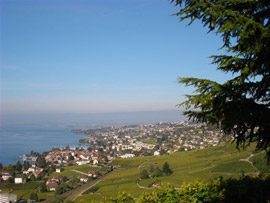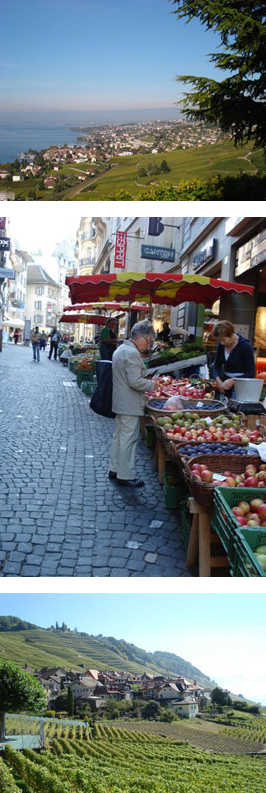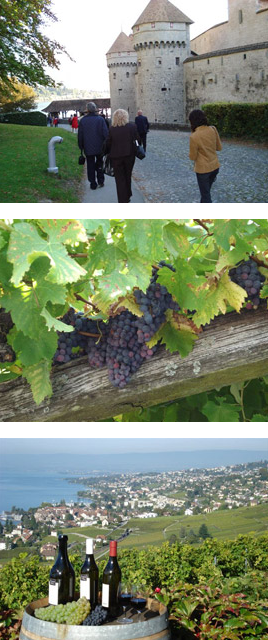Journeys with Carole Kotkin
Switzerland’s Lavaux Region


Carole Kotkin is a syndicated Miami Herald food columnist and co-author of “MMMMiami – Tempting Tropical Tastes for Home Cooks Everywhere.” She is also the manager of The Cooking School at The Ocean Reef Club, food editor for “The Wine News” magazine, and co-host of “Food and Wine Talk” on southfloridagourmet.com.

Spectacular scenery, historical hamlets, watches, chocolate, cheese – this can only be Switzerland. But when it comes to wine, Switzerland is full of surprises. Switzerland has just slightly more than seven million inhabitants, but their passion for wine has long supported native wineries and regional diversity. Wine is produced in nearly all 23 cantons (and two half-cantons) that make up the Swiss confederation.
Until recently, most Swiss wines were only enjoyed locally. Now, the Swiss have stepped up efforts to sell them outside their borders. Last June, the Lavaux region was recognized by UNESCO and was registered on their World Heritage list. It became the sixth wine growing area in the world to receive this distinction. The Lavaux region in the Canton de Vaud has produced wine for more than 1,000 years on a series of stone terraces overlooking Lake Geneva. Today, the slopes are dotted with wine-producing villages and 270 wine growers. The region does produce some red wine, but 70% of the wine output is white wine made with the Chasselas grape. Chasselas makes distinctive, fruity, light-bodied whites, often slightly spritzy. They go well with some regional specialties (such as perch fillets from the Swiss lakes) and fondue, râclette and other cheese dishes. However, these wines lack the structure to handle richer or spicier foods.
The soil in the terraces of the eight different appellations in the Lavaux is rich and varied relying on “three suns”—the sunlight reflected off Lake Geneva, as well as the solar heat stored in the stone terraces. Because of the sloped terraces, machines cannot be used and all harvesting is done by hand. Domaine du Dulay has been producing wines for more than 600 years. My companions and I walked through the vineyards, tasted wine straight from the barrels and enjoyed a wine tasting with local cheeses and breads. Tour of this vineyard, as well as others on the hills above Lake Geneva, are available by pre-appointment: www.swisswine.ch.
Switzerland is small enough for wine lovers to visit the leading regions easily. Valais, the largest viticulture area, where 52 different grape varieties are grown, is a 90-minute drive from Geneva on a scenic elevated freeway. Vaud, the second largest wine canton, is a one-hour drive from Geneva and is dotted with traditional vigneron villages such as Cully and St.-Saphorin in Lavaux. Geneva is the third largest winegrowing canton.

The love of wine drew me here, but it is not the only reason to visit this region. You will be charmed b the city of Lausanne which scenically stands above Lake Geneva and the surrounding countryside with tiny villages that delight the eye. There are chocolates at every turn, great local cuisine and the omnipresent bottle of local wine. The city’s hallmark attraction is the Olympic Museum offering a collection of interactive exhibits with memorabilia from Olympics past. While you explore downtown Lausanne, make sure to visit Durig Chocolatier, who has been making Swiss chocolates for more than a decade. You can watch through the street-front windows as Durig and his assistant make candies using chocolates from around the world. Lausanne’s open-air vegetable market and expensive European shops and cafes are also must-dos.
Built in the 13th century on Roman foundations, Chillon Castle (above, left), the most impressive and most photographed medieval castle in Europe is well worth a visit – torture chambers, secret passageways, and stunning vistas transport you to a fairy tale land. The prison in the depths of the castle drew Lord Byron, who wrote a poem, The Prisoner of Chillon, about Franois de Bonivard, a priest who spent four years chained to a post there in the 16th century. As an added treat, take the steam-powered paddleboat “La Suise” to Lausanne to experience breathtaking scenery.
If you can afford luxury, the place to stay in Lausanne is the 140-year old Beau-Rivage Palace. Situated at the edge of Lake Geneva on 10 acres of parkland, the hotel epitomizes European elegance. Built in the mid-1800s, the Beau-Rivage recently underwent an extensive renovation and has just opened a full-service spa. Emperor Hirohito, Nelson Mandela, Coco Chanel, the Duke and Duchess of Windsor, Winston Churchill and members of Royal households have signed their guest book. The Beau Rivage Palace, for all its echoes of a bygone age, is firmly rooted in the 21st century and provides current guests with all the modern facilities they require. La Rotonde, the hotel’s gourmet restaurant, recently received one star from the Michelin guide. Lunch in Lausanne should not be hurried, especially if taken at the Cafe Beau-Rivage over-looking Lake Geneva. While the decor is all marble and fine old-world furnishings, the menu in this Parisian-style brasserie is decidedly contemporary. The lunchtime offering is varied and the hotel takes pride in its use of local produce. The food is exquisitely presented and the dessert menu is a showcase of indulgence: a variety of tarts, cheeses (regional and otherwise) and ice-cream.


